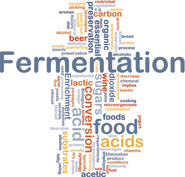How to Get Comfortable With Fermented foods
By Michelle Branco
 If you’re used to the careful packaging of most processed foods, the idea of eating something where bacterial growth is actually encouraged requires a certain amount of faith. Even if you’ve dabbled in canning, or maybe especially so, replacing the destruction of bacteria with its careful nurturing is something of a leap. But this article will reassure you of the safety of fermented foods. If you’re used to the careful packaging of most processed foods, the idea of eating something where bacterial growth is actually encouraged requires a certain amount of faith. Even if you’ve dabbled in canning, or maybe especially so, replacing the destruction of bacteria with its careful nurturing is something of a leap. But this article will reassure you of the safety of fermented foods.
Despite what you could consider a natural wariness, fermented foods exist in virtually every traditional diet – whether as vegetables, dairy, or grains. Even without the level of hygiene in our modern kitchens, lacto-fermentation in particular is effective at long-term preservation because the lacto-bacteria are extremely effective at killing off other bacteria and the acid environment they create is inhospitable (but tasty!).
Effective as a method of preserving the harvest, fermented foods are also nutritional powerhouses, maximizing the availability of nutrients and nurturing the healthy bacterial flora of the eater. Fermentation breaks down compounds that are indigestible, making foods edible that might otherwise be hard to digest. At the same time, research summarized in a 1995 WHO/FAO report on fermented foods shows that by changing the ph levels in foods, nutrients that would have been poorly absorbed can be used effectively by the body – namely, calcium, iron, and zinc. At the same time, vitamin C is unaffected by fermentation, which further increases the availability of iron in the food.
The live bacteria does more than just alter the food. When consumed, it changes the body as well. In a 2004 review of current evidence, a researchers group noted several animal studies that indicate that the consumption of lacto-bacteria in common foods improves the body’s ability to respond to both infection and inflammation quite dramatically. As we increase our understanding of the connection between diet, gut health, and the immune system, it seems increasingly clear that science is figuring out what peasants have known for generations: Sometimes a little “sour” is just what the body needs.
While I’m willing to embrace the idea of fermented foods, it does pose something of a problem to the modern cook. By their nature, live fermented foods are unpredictable and sensitive to their environment, so distribution through grocery store supply chains is understandably problematic.
Of course, scale becomes a problem in the other direction when the home cook considers setting up a nurturing environment for some countertop fermentation. Recipes that have yields in the gallons and usually include buckets are probably very close to the original, but may not be realistic given the size of today’s families and kitchens.
Food Safety & Fermentation
Unlike traditional preserving, you won’t be using high heat and hermetic seals to keep food from spoiling, so you need to take special care not to introduce pathogenic bacteria while you nurture the healthy bacteria.
- Sterilize all utensils, jars, and crocks before using.
- Wash hands and cutting surfaces thoroughly.
- Use healthy, peak-of-ripeness produce, preferably organic.
- This is not a time to skimp on salt – a minimum level of salt and acidity is needed to inhibit the growth of dangerous bacteria.
- Wash and dry all produce well.
- During fermentation, keep little (and big) fingers out of crocks and away from excessive heat or cold that might disturb the process.
- Refrigerate or can for longer-term storage.
- “Sour” does not mean rotten; discard food that has turned color, smells foul, or has become mushy.
Michelle Branco is a freelance writer and blogger about mothering, breastfeeding, product safety and, of course, food. She is also an International Board Certified Lactation Consultant .
word graphic © Kheng Guan Toh/Shutterstock Images
|

